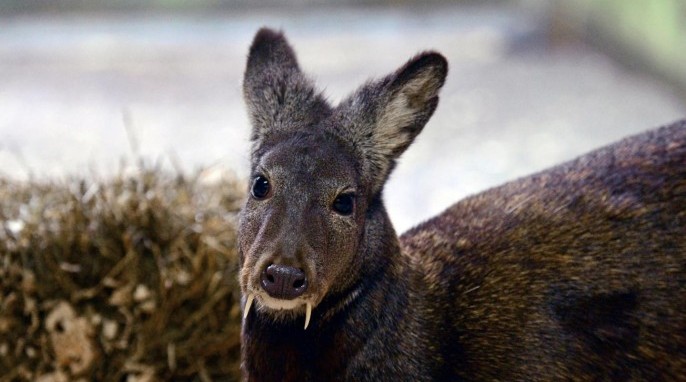Fanged Musk Deer Found Alive in Afghanistan
The endangered Kashmir fanged musk deer and its unusual set of fangs hasn’t been seen in about 60 years, until now.
The strange deer with tusks that look like vampire fangs has been sighted in the rugged forested slopes of northeast Afghanistan, according to a research team led by the Wildlife Conservation Society (WCS). The team confirmed the presence of the deer in Nuristan Province during recent surveys.
So where has the fanged musk deer been hiding, and what are those fangs for, anyway?
The Kashmir musk deer is one of seven similar species found across Asia. The male musk deer has distinct saber-like tusks that protrude from its mouth and are used during the mating season to compete with other males. Musk deer do not have horns, so they use their fangs, instead. The last scientific sighting of these rare animals in Afghanistan was reported by a Danish survey team exploring the region in 1948.
RELATED: GOATS IN THE ITALIAN ALPS ARE SHRINKING
The Kashmir musk deer is categorized as an endangered species due to habitat loss and poaching. Poachers often hunt the animal for its scent glands. The scent glands are coveted by wildlife traffickers and are considered more valuable by weight than gold, fetching as much as $45,000/kilo on the black market. As is the case with so many endangered animal parts, the scent is generally sold to people who think it is an aphrodisiac.
But the Kashmir musk deer isn’t gone from Afghanistan, yet. The WCS survey team recorded five sightings of these endangered animals, including a solitary male in the same area on three occasions, one female with a juvenile, and one solitary female. All of the sightings were in steep rocky outcrops interspersed with alpine meadows and scattered, dense high bushes of juniper and rhododendron.
Although the deteriorating security conditions in Nuristan did not allow NGOs to remain in Nuristan after 2010, the Wildlife Conservation Society maintains contact with the local people it has trained and will pursue funding to continue ecosystem research and protection in Nuristan when the situation improves.
“Musk deer are one of Afghanistan’s living treasures,” said Peter Zahler, WCS Deputy Director of Asia Programs. “This rare species, along with better known wildlife such as snow leopards, are the natural heritage of this struggling nation. We hope that conditions will stabilize soon to allow WCS and local partners to better evaluate conservation needs of this species.”
Even thought their fangs can be disconcerting, musk deer are herbivores. They live in hilly, forested environments, preferring to remain far away from human habitation. Like true deer, they eat mainly leaves, flowers, and grasses, with some mosses and lichens. They are solitary animals, and maintain well-defined territories, which they scent mark with their caudal glands. Musk deer are generally shy and nocturnal.
The WCS team has written that targeted conservation of the species and its habitat are needed for it to survive in Afghanistan.
The team’s report has been published in the Oct. 22nd edition of the journal Oryx. Authors include Stephane Ostrowski and Peter Zahler of the Wildlife Conservation Society, Haqiq Rahmani of the University of Leeds, and Jan Mohammad Ali and Rita Ali of Waygal, Nuristan, Afghanistan. This study was funded by the United States Agency for International Development (USAID).
Photo: Musk Deer in Siberia (Julie Larsen Maher, WCS)




